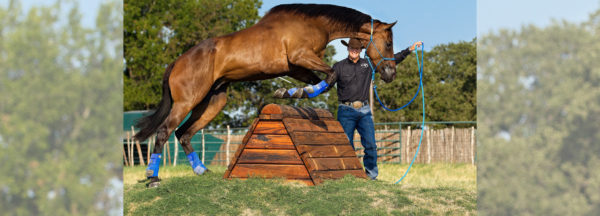Training Tip: Steady Pressure vs Driving Pressure

There are two types of pressure—steady pressure and driving pressure. Steady pressure is just that, a steady, consistent pressure. Driving pressure has a pulsating beat or rhythm to it—one, two, three, four; one, two, three, four. When you ride a horse, you use mostly steady pressure. You squeeze with your legs or pull on the reins, and the horse moves off that steady pressure. On the ground while doing groundwork, a lot of techniques require you to use driving pressure because you’re farther away from the horse.
Horses are born with the instinct to lean and push against pressure. Mother Nature tells the horse to pull away and fight against pressure to survive an attack from a predator. It’s your job as a trainer to teach your horse to yield and soften to both types of pressure. In fact, horses love to lean on steady pressure. And because they’re bigger and stronger than us, they always win. They know that when they lean on pressure, we’ll push back and they can out-muscle us.
When working with an adult horse, it’s usually easier to first teach him to respond to driving pressure rather than steady pressure. This is especially true if the horse has been allowed to become pushy and disrespectful and ignore people. The longer a horse has been allowed to be pushy, the duller he’ll be and the easier it will be for him to ignore pressure. It’s much harder for a horse to lean on driving pressure than it is for him to lean on steady pressure because driving pressure has a rhythm to it.
For example, imagine that you’re at a clinic sitting in a lawn chair. You can probably sit in that chair for a good hour or so before it starts to feel uncomfortable to you. And even when it does start to become a little uncomfortable, there’s a good chance you’ll continue to sit there for a while longer because it’s not enough to motivate you to find another place to sit. Now imagine that your lawn chair started jumping up and down about three inches off the ground very quickly. The pressure isn’t enough to throw you out of the chair, but how long do you think you’d continue sitting there? Probably not very long because it would feel uncomfortable. In a short matter of time, you would find a more comfortable chair to sit in. The pressure didn’t force you to get up out of the chair; it just made you feel uncomfortable enough to look for another answer. That’s the same way pressure works when you’re training your horse. As a general rule, it’s easier to teach a horse to respond to driving pressure first, and when he gets the hang of it, then introduce him to steady pressure.
